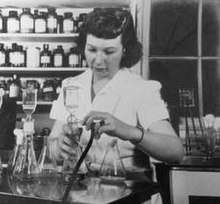Elizabeth Bugie
Elizabeth Bugie Gregory (October 5, 1920 – April 10, 2001) was an American biochemist who identified Streptomycin, an antibiotic that was active against Mycobacterium tuberculosis. Selman Waksman went on to win the Nobel Prize for Medicine in 1952 and took the credit for the discovery.
Elizabeth Bugie | |
|---|---|
 Elizabeth Gregory in the lab | |
| Born | October 5, 1920 |
| Died | April 10, 2001 (aged 80) |
| Alma mater | Rutgers University New Jersey College for Women |
| Known for | Streptomycin |
| Scientific career | |
| Thesis | Production of antibiotic substances by Aspergillus flavus and Chaetomium cochliodes (1944) |
| Doctoral advisor | Selman Waksman |
Early life
Bugie's father, Charles Bugie, never studied beyond high school, and was committed to her education.[1] Her mother was Madeline Turbett. Bugie studied microbiology at the New Jersey College for Women.[1] She was a Masters student at Rutgers University, working with Selman Waksman.[1] She developed several antimicrobial substances.[2][3] Her Masters thesis, Production of antibiotic substances by aspergillus flavus and chaetomium cochliodes, looked to optimise the production of flavicin and chaetomin.[4]
Career
Bugie worked on antimicrobials that could protect plants from Dutch elm disease.[5] In 1944 Bugie, Waksman and Schatz identified streptomycin in cultures of soil organisms, an antibiotic which was found to be active against Mycobacterium tuberculosis.[6][7] Bugie was told that it was not important for her name to be on the patent as she would "one day get married and have a family".[1][8] Selman Waksman went on to win the Nobel Prize for Medicine in 1952 and took all the credit for the discovery.[1] Waksman claimed that Bugie was more involved in the discovery than Albert Schatz.[9][10] Bugie was eventually awarded 0.2% of the royalties for streptomycin.[11] After the discovery of streptomycin, Bugie worked on micromonosporin, a pigmented glycoprotein that was active against gram-positive bacteria.[12] Bugie worked for Merck & Co., evaluating pyrazinoic acid and penicillin as antibiotics against mycobacterium tuberculosis.[13] After raising her family, Bugie eventually returned to academia to study library science.[1]
Bugie's daughter, Eileen Gregory, is a microbiologist at Rollins College.[1] Bugie died on April 10, 2001.
References
- Angelova, Lidiya. "Elizabeth Bugie – the invisible woman in the discovery of streptomycin". Scientista | Women in STEM. Retrieved 2018-08-16.
- Waksman, Selman A.; Bugie, Elizabeth (September 1943). "Strain Specificity and Production of Antibiotic Substances". Proceedings of the National Academy of Sciences of the United States of America. 29 (9): 282–288. doi:10.1073/pnas.29.9.282. ISSN 0027-8424. PMC 1078613. PMID 16578091.
- Waksman, S. A.; Bugie, E. (November 1944). "Chaetomin, a New Antibiotic Substance Produced by Chaetomium cochliodes: I. Formation and Properties". Journal of Bacteriology. 48 (5): 527–530. ISSN 0021-9193. PMC 374002. PMID 16560863.
- Production of antibiotic substances by aspergillus flavus and chaetomium cochliodes.
- Waksman, Selman A.; Bugie, Elizabeth (1943-10-01). "Action of Antibiotic Substances Upon Ceratostotnella ulmi". Proceedings of the Society for Experimental Biology and Medicine. 54 (1): 79–82. doi:10.3181/00379727-54-14310. ISSN 0037-9727.
- "History of medicine - Medicine in the 20th century". Encyclopedia Britannica. Retrieved 2018-08-16.
- Schatz, Albert; Bugle, Elizabeth; Waksman, Selman A. (1944-01-01). "Streptomycin, a Substance Exhibiting Antibiotic Activity Against Gram-Positive and Gram-Negative Bacteria.∗†". Proceedings of the Society for Experimental Biology and Medicine. 55 (1): 66–69. doi:10.3181/00379727-55-14461. ISSN 0037-9727.
- "Elizabeth (Bugie) Gregory - published landmark article in 1944 - Newspapers.com". Newspapers.com. Retrieved 2018-08-16.
- "Selman Waksman and Antibiotics - Landmark - American Chemical Society". American Chemical Society. Retrieved 2018-08-16.
- "Streptomycin — arrogance and anger". Pharmaceutical Journal. Retrieved 2018-08-16.
- "Their Dispute Over Discovery of Streptomycin Is Settled". www.albertschatzphd.com. Retrieved 2018-08-16.
- Waksman, Selman A.; Geiger, Walton B.; Bugie, Elizabeth (March 1947). "Micromonosporin, an Antibiotic Substance from a Little-known Group of Microorganisms 1". Journal of Bacteriology. 53 (3): 355–357. ISSN 0021-9193. PMC 518315. PMID 16561279.
- Eveleigh, Douglas E.; Bennett, Joan W. (2018-05-01). Women Microbiologists at Rutgers in the Early Golden Age of Antibiotics. doi:10.1128/9781555819545. ISBN 9781555819538.